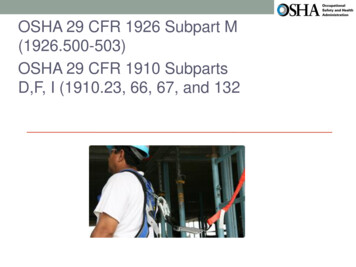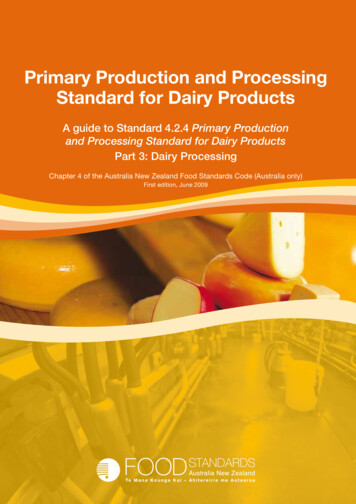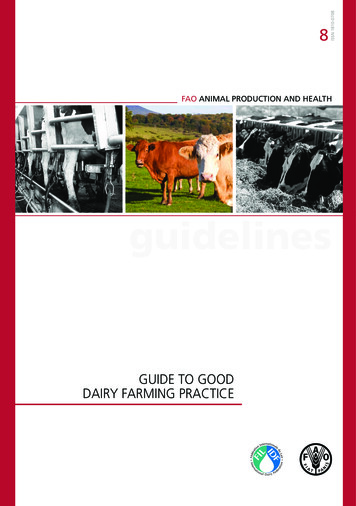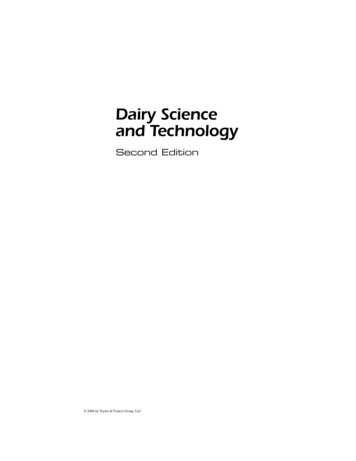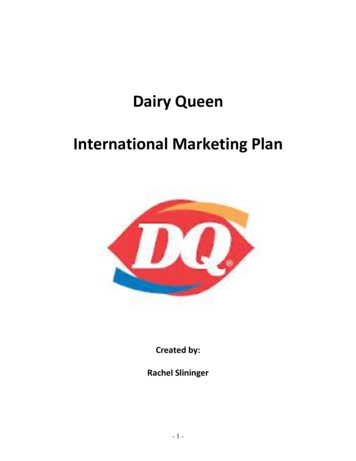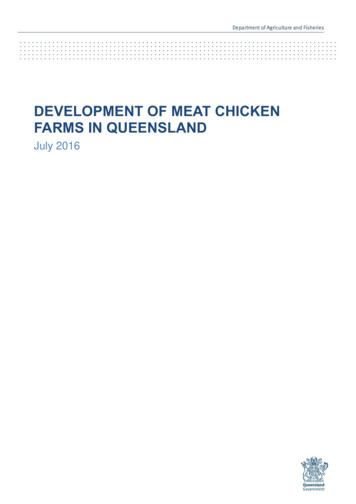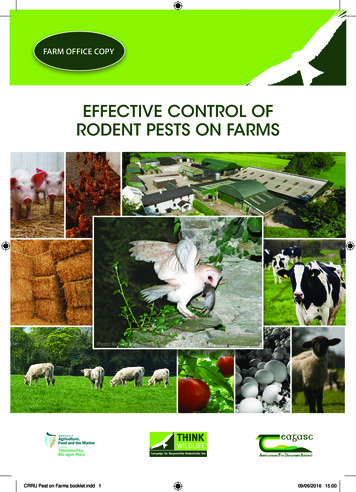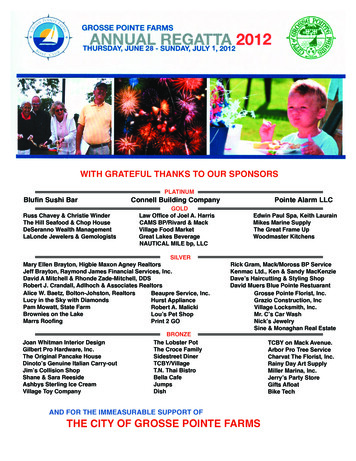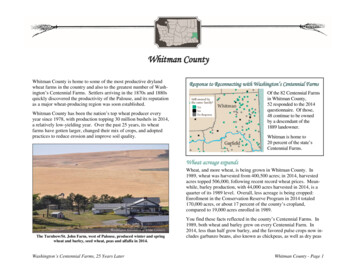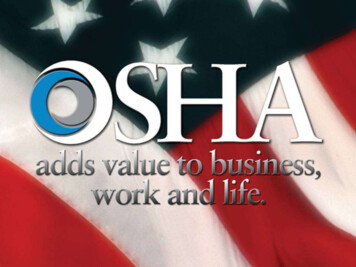
Transcription
OSHA Basics forDairy FarmsUW-Extension WebinarDecember 10, 2010Mary BauerCIH, CSPCompliance Assistance SpecialistEau Claire, WI 54701715-832-9019 bauer.mary@dol.gov
My Background Mary Bauer––––––25 years w/ OSHAIH/ SafetyCIH: Certified Industrial HygienistCSP: Certified Safety Professional1000 InspectionsGrew up on Dairy Farm – 35 Milk Cows
Objectives How to spell “OSHA”What OSHA does - MissionWho OSHA has jurisdiction withStandards and Hazard in Dairy/AgricultureOSHA Enforcement ProcessOSHA OutreachQuestion & Answers
OSHA Occupational Safety and Health ActWilliams-Steiger Act – 1970William Steiger – Congressman from Oshkosh, WI OSH Act was signed Dec 29, 1970 byPresident Richard Nixon
OSHA’s Mission To assure so far aspossible everyworking man andwomen in thisnation a safe andhealthful workingconditions
Prior To OSHA Walsh – Healy Act– Safety Provisions for government contracts. Non-Regulatory:––––NSC: National Safety CouncilANSI: American National Standards InstituteNFPA: National Fire Protection AssociationACGIH: American Conf. of Gov’t Ind. Hygienist
Major EmployerResponsibilities Provide a workplace free fromrecognized hazards Comply with OSHA standards andregulations Be familiar with standardsapplicable to their workplace
Employee Rights Request OSHA investigationName withheld from ER –complaintTalk with compliance officersParticipate in inspection and afterinspection action. Offered Whistleblower Protection 11( c)
Employee Rights Review OSHA standards, rules andregulations available in the workplace. Request information from ER on S&Hhazards, precautions, emergencyprocedures, Receive adequate training and information
OSHA Coverage Private Sector Employees– Manufacturing– Construction– Maritime– Health Care– Warehousing
OSHA does NOT cover Self – Employed Farming– Immediate Members of the Families– 10 or less Employees unless Temporary Labor Camp If another agency has jurisdiction– FAA, RR, DOT, NRC, MSHA, EPA Public Employees
Appropriations Rider Issues:CPL w document?p table DIRECTIVES&p id 1519A "farming operation" means any operation involved in the growing orharvesting of crops, the raising of livestock or poultry, or relatedactivities conducted by a farmer on sites such as farms, ranches,orchards, dairy farms or similar farming operations. These areemployers engaged in businesses that have a two digit StandardIndustrial Classification (SIC) of 01 (Agricultural Production - Crops),02 (Agricultural Production - Livestock and Animal Specialties), andfour digit SIC 0711 (Soil Preparation Services), 0721 (Crop Planting,Cultivating, and Protecting), 0722 (Crop Harvesting, Primarily byMachine), 0761 (Farm Labor Contractors and Crew Leaders), and0762 Farm Management Services).A "temporary labor camp" means farm housing directly related to theseasonal or temporary employment of farm workers.
Appropriations Rider Issues A farming operation is exempt from all OSHAactivities if it:––Employs 10 or fewer employees currently and at alltimes during the last 12 months; andHas not had an active temporary labor camp duringthe proceeding 12 months.Family members of farm employers are not counted whendetermining the number of employees.Part Time Employee is counted as “1” employee.
Standards Relating toAgriculture 29 CFR 1928: Agriculture http://www.osha.gov/pls/oshaweb/owasrch.search form?p doc type STANDARDS&p toc level 1&p keyvalue 1928 29 CFR 1910: General Industry: AsReferenced http://www.osha.gov/pls/oshaweb/owasrch.search form?p doc type STANDARDS&p toc level 1&p keyvalue 1910 General Duty Clause – Section5(a)(1)
Recordkeeping Employers of 11 ormore employeesmust maintainrecords ofoccupationalinjuries andillnesses
1904.2 -Recordkeeping All industries in agriculture,construction, manufacturing,transportation, utilities andwholesale trade sectors arecovered 1904.1 – Size Exemption:– If your company had 10 or feweremployees at all times during thelast calendar year, you do notneed to keep the injury and illnessrecords unless surveyed by OSHAor BLS
Agricultural Standards: 1928 1928.51– Roll-over protective structures (ROPS) for tractorsused in agricultural operations. 1928.57– Guarding of farm field equipment, farmsteadequipment, and cotton gins. 1928.110 - Field Sanitation.
Employee Operating Instructions1928 Subpart C App A1. Securely fasten your seat belt if the tractor has a ROPS.2. Where possible, avoid operating the tractor near ditches,embankments, and holes.3. Reduce speed when turning, crossing slopes, and on rough, slick, ormuddy surfaces.4. Stay off slopes too steep for safe operation.5. Watch where you are going, especially at row ends, on roads, andaround trees.6. Do not permit others to ride.7. Operate the tractor smoothly - no jerky turns, starts, or stops.8. Hitch only to the drawbar and hitch points recommended by tractormanufacturers.9. When tractor is stopped, set brakes securely and use park lock ifavailable.
General Industry WhenReferenced in 1928.21(a) 1928.21(b) Except to the extent specified in paragraph (a) of this section, the standardscontained in Subparts B through T and Subpart Z of part 1910 of this title do not apply toagricultural operations. 1928.21(a): The following standards in part 1910 of this Chapter shall apply to agriculturaloperations: 1928.21(a)(1): Temporary labor camps - 1910.142; 1928.21(a)(2): Storage and handling of anhydrous ammonia - 1910.111(a) and (b); 1928.21(a)(3): Logging Operations - 1910.266; 1928.21(a)(4): Slow-moving vehicles - 1910.145 1928.21(a)(5): Hazard communication - 1910.1200 1928.21(a)(6): Cadmium - 1910.1027 1928.21(a)(7): Retention of DOT markings, placards and labels - 1910.1201
General Duty Clause Section 5(a)(1) of theAct ".that each employer shallfurnish.employment and aplace of employment which arefree from recognized hazardsthat are causing or are likely tocause death or seriousphysical harm to hisemployees." Applies when there is nospecific standard
General Duty Clause ElementsEmployee ExposureSerious HazardKnowledgeAbatement MethodRecognition
Common Hazards Toxic Substances/Airborne DustsElectricalFallHazardous Waste / Hazardous chemicalsFire and ExplosionDangerous AtmospheresMachine GuardingConfined SpaceLockout – Unexpected Energy ReleaseNoise
Top Four Construction Hazards90% of Injuries and Deaths Falls, (e.g., floors, platforms, roofs) Struck by, (e.g., falling objects, vehicles) Caught in/between (e.g., cave-ins, unguardedmachinery, equipment) Electrical (e.g., overhead power lines, power toolsand cords, outlets, temporary wiring)
RegionVRegion VLocalEmphasisProgramforLocal Emphasis Program forGrainHandlingFacilitiesGrain Handling FacilitiesCPL 04-00 (LEP 017) August 02.2010
Warning Letter to Grain Industryhttp://www.osha.gov/asst-sec/Grain letter.html
S&H Top Hazards: Grain LEP Engulfment Auger Entanglement Struck By Fall Protection Electrocution Combustible Dust Explosions
Machine Guarding: 1928.57
1910.147: Control of HazardousEnergy Lockout-Tagout (5a1) Written LOTOProcedures– Some equipment isexempt Individual EmployeeProtection (Locks) ShiftChange/AuthorizedLock Removal Annual Audit
Personal ProtectiveEquipment (PPE): 5a1 1910.132 – Hazard Assessment– Required PPE– Written Certification– Training Specific Requirements1910.133 – Eye / Face1910.135 – Head1910.137 – Electrical1910.95 - Noise1910.134 – Respiratory1910.136 - Foot1910.138 – Hand
1910.146 or 1910.272: PermitRequired Confined Spaces (5a1) Identify Permit Required C.S. in workplaceProhibit Unauthorized EntryWritten ProgramEntry Procedures– Entry Permit– Alternate Procedures– Reclassify to “Non-Permit Required” Annual Audit
Handling Bridged Grain!1910.272(g)(iv)(6) ViolationIf grain bridges:- Stop the auger- Break up the bridge with a long wooden pole (not metal)“.entrapment and burial can occur within seconds”
Manure Pits-Lagoons (5a1) Established Standard:– American Society of Agricultural andBiological Engineers (ASABE) ASEA EP470 Jan 1992 (R2005) Manure Storage Safety– Waste Storage Facility National Resources Conservation Service Code 313 Hazard: Hazardous Atmosphere, Falls
Entry Concern
Guarding Access- PreventBacking into Area – PTO Shaft
Slurry Tanks – Sand CleanoutEntry Concern
1910.178: Powered Industrial TrucksForklifts: Skid Steers (5a1) Operator Training Capacity / Stability / Operator Inspections Workplace Topics / Surface Conditions Refresher Training Evaluation of Performance– At Least Every Three Years Written Certification
Powered Industrial VehiclesNot Included in Agriculture http://www.osha.gov/pls/oshaweb/owadisp.show document?p table INTERPRETATIONS&p id 22785 the final rule of §1910.178 did not amend§1928.21(a) to add §1910.178 to this listof applicable general industry standards.Thus, for those employments, which are"agricultural operations" under Part 1928,§1910.178 does not apply.
1910.1200Hazard Communication Material Safety Data Sheets– Hazards of Chemical (Flammable,Toxic )– Personal Protective Equipment Labeling– Specific Chemicals– Types of Chemical Hazards Training Written Program
Dairy Inspection: FatalityAvailable on Website Val-O-Farms, Inc. ion detail?id 313176083
Basic Strategic Goals Strong, fair & effective enforcement Outreach, education, and complianceassistance Partnership and other cooperativeprograms
Inspection Priorities Inspection Types:– ID - Imminent Danger– FAT/CAT-(Fatality/Catastrophe)– Complaint / Referral– General Schedule
Fatality / Catastrophe Fatality: One or more Catastrophe:– 3 or more Hospitalized ( admitted )ER must report to OSHA w/in 8 hours.OSHA Hotline. 1-800-321-OSHA
OSHA Emergency Hot-Line1-800-321-OSHA Hot-line forreportingworkplace safety orhealthemergencies Provides a 24-hourpoint of contact toreport imminentdangers on the job
Complaints Formal– Signed by a present employee orrepresentative of employee– Request on-site inspection Non-Formal or Investigation– Phone/Fax– ER responses in writing in 5 days
Referral Another Agency– Wage & Hour has Temporary Camp Jurisdiction andcan refer to OSHA– Police or Coroner– UW-Extension Another CSHO Self-Referral – “Drive-By”– Limited in Dairy
Drive – By Self Referrals
General Schedule General Industry Construction Emphasis Programs– LEP– NEP– SEP Lead, Falls, Silica, Isocyanates, Plating, Concrete, SST, PIV– Dairy: Concentrated Animal Feeding Operation(CAFO)
CSHO Compliance Safety and Health Officer Safety and/or Health Disciplines Authorized to Enter Workplace Without Advanced Notice Inspect & Investigation Conditions Question Privately Employees and Employer
On-Site Inspection Presentation of CredentialsOpening ConferenceRecords ReviewProgram ReviewWalkaroundClosing Conference
Legal Sufficiency –Documentation of Violations Violation:– Exposure to Hazard ActivityHow oftenTrainingExact Distances– Hazard Cause Harm– Employer Knowledge– Existing Standard
Post Inspection Element– Citation Issuance Classification Penalties– Appeal Process Informal Conference Contest Rights– Final Order– Abatement Submission
Administrative Penalty lty.html
Background OSHA penalties have not been adjusted forseveral decades Work group assembled to evaluate theAgency’s penalty policies Conclusion of the work group – currentpenalties are too low to have an adequatedeterrent effect New changes announced April 22, 2010
Administrative Penalty Changes1.2.3.4.5.Gravity-Based PenaltySizeHistoryGood FaithIncreased MinimumPenalties6. Severe ViolatorEnforcement Program7. Repeat Violations8. Informal ConferenceConsideration9. Application ofpenalty adjustmentfactors
Gravity-Based PenaltyCurrentNewHigh/Greater 5,000 or 7,000 7,000Medium/Greater 3,500 6,000Low/Greater 2,500 5,000High/Lesser 2,500 5,000Medium/Lesser 2,000 4,000Low/Lesser 1,500 3,000
SizeCurrent ReductionNew Reduction1 - 2560%40%26 - 10040%30%101 - 25020%10%251 or moreNoneNone
HistoryCurrentConsiderprevious 3 yrsCitationswithin theprevious 3 yrsNew10% reductionInspected and noSWRF citations inthe previous 5 yrs10%reductionNo reductionInspected and HGcitations issued inthe previous 5 yrs10%increaseNever inspected orno HG citations inthe previous 5 yrsNoreductionor increase
Good Faith New policy will retain evaluating anemployers safety and health program The additional 10% reduction for participationin a strategic partnership has been eliminated
Increased Minimum Penalties Minimum penalty for a serious is increasingfrom 100 to 500 Minimum penalty for a posting violation willincrease from 100 to 250 if the companywas previously provided a poster by OSHA
In effect 10-1-2010 All inspections with an opening conferencedate on or after 10-1-2010 will be underthe new calculations All prior to 10-1-2010 opening conferencedates will be under the old policy
Severe Violator EnforcementProgram Modifies guidance for grouping related HGserious violations and permits citing each withits own penalty AD may limit adjustment for SVEP relatedviolations to achieve the appropriate deterrenteffect
Repeat ViolationsCurrentNewProposed if a finalorder citation inthe previous 3 yrsProposed if afinal ordercitation in theprevious 5 yrs
Informal Conference ConsiderationCurrentNew-AD may reducepenalty up to 50%- AD may reduce penalty up to 30%. 30 % reduction requires RAapprovalGreater than 50%requires RA approval- AD may offer an additional 20% ifan outside H&S consultant is hired- No longer allow penalty reductionwhen employer has an outstandingbalance owed to OSHA at thisestablishment or others. If on apenalty plan, penalty reduction maybe granted.
Application of Penalty Adjustment Factors All penalty reduction factors summed andmultiplied by the Gravity-Based Penalty(GBP)--currently Penalty adjustment factors will be appliedserially to the GBP---new policy
Serial adjustment
Impact Medium size employer 50 employees Received a serious (HG) citation fouryears ago Good safety program
Serious ViolationHigh Severity Lesser Probability Old System 2500History -10%Good Faith -15%Quick Fix -15%Size -40% 500 New System 5000 History 10% 5500 Good Faith – 15% 4675 Quick Fix -15% 3973.75 Size -30% 2781.62
Summary Dairy Farms will be inspected Hispanic Outreach Emphasis Program Training Critical:– In the language understood Documentation Important
Safety and Health ResourcesWeb Page AssistanceCompliance Assistance Quick Start is a tool tointroduce employers and employees,especially those at new or small businesses, tothe compliance assistance resources onOSHA’s website. Quick Start currently includesmodules for: General Industry Construction Health Care Hispanic OutreachBy following the step-by-step guides, you cangenerate an initial set of complianceassistance materials tailored to yourworkplace
Resources: Safety Pays
Resources: Publications PageOn the Web
Web Page E-toolsThe E-Tool provides a detailed review of the technically complex requirementsof a particular standard or issue; inform employers of their obligations todevelop the appropriate hazard prevention and control methodologies; and theE-Tool seeks to clarify specific topics that are often questioned ormisunderstood by explaining the requirements, referencing OSHA interpretationletters and related industry consensus standards and highlights some bestpractices.Provides useful ways of empowering workers to understand the steps theiremployers must implement in order to provide them with a safe and healthfulwork environment.Grain Handling
Outreach, Education andCompliance Assistance www.osha.gov– E-tools– Subject Index Compliance Assistance MaterialsOSHA Training InstituteOSHA Training Grants (FISTA)OSHA CONSULTATION ServiceCompliance Assistance Specialists with in AreaOffices (CAS)
EauClaireMadisonAppletonMilwaukee
Wisconsin Compliance Assistance SpecialistsKelly BubolzU. S. Dept. of Labor - OSHA1648 Tri Park WayAppleton, WI 54914(920) 734-4521Leslie PtakU. S. Dept. of Labor - OSHA4802 E. BroadwayMadison, WI 53716(608) 441-5388Mary BauerU. S. Dept. Of Labor - OSHA1310 W. Clairemont AveEau Claire, WI 54701(715) 832-9019Patrick Ostrenga/Jim LutzU. S. Dept. of Labor - OSHA310 W. Wisconsin AveMilwaukee, WI 53203(414) 297-3315
Wisconsin Construction & GenIndustry Safety Newsletters Published 3-4 timeseach year Focuses onupcoming and hottopics Provides Regionalfatality data and mostfrequently citedissues
State Consultation Service1-800-947-0553 Provided at no cost to employers Developed for smaller employers withmore hazardous operations Delivered by WiSCon or the StateLaboratory of Hygiene No penalties are proposed or citationsissued Possible violations of OSHA standardsare not reported to OSHA enforcementstaff unless employer fails to eliminate orcontrol any serious hazard or imminentdanger
Section 11(c)Discrimination can include:––––Firing or laying offBlacklistingDemotingDenying overtime orpromotion– Disciplining––––Denial of benefitsFailure to hire or rehireIntimidationReassignmentaffecting futurepromotions– Reducing pay or hours
QUESTIONS
Disclaimer This information has been developed by an OSHA Compliance AssistanceSpecialist and is intended to assist employers, workers, and others as theystrive to improve workplace health and safety. While we attempt tothoroughly address specific topics or hazards, it is not possible to includediscussion of everything necessary to ensure a healthy and safe workingenvironment in a presentation of this nature. Thus, this information must beunderstood as a tool for addressing workplace hazards, rather than anexhaustive statement of an employer’s legal obligations, which are definedby statute, regulations, and standards. Likewise, to the extent that thisinformation references practices or procedures that may enhance health orsafety, but which are not required by a statute, regulation, or standard, itcannot, and does not, create additional legal obligations. Finally, over time,OSHA may modify rules and interpretations in light of new technology,information, or circumstances; to keep apprised of such developments, or toreview information on a wide range of occupational safety and health topics,you can visit OSHA’s website at www.osha.gov.
Dec 10, 2010 · OSHA Basics for Dairy Farms UW-Extension Webinar December 10, 2010 Mary Bauer CIH, CSP Compliance Assistance Specia
